Categories
From Soil, Sand, and Salt Crystals
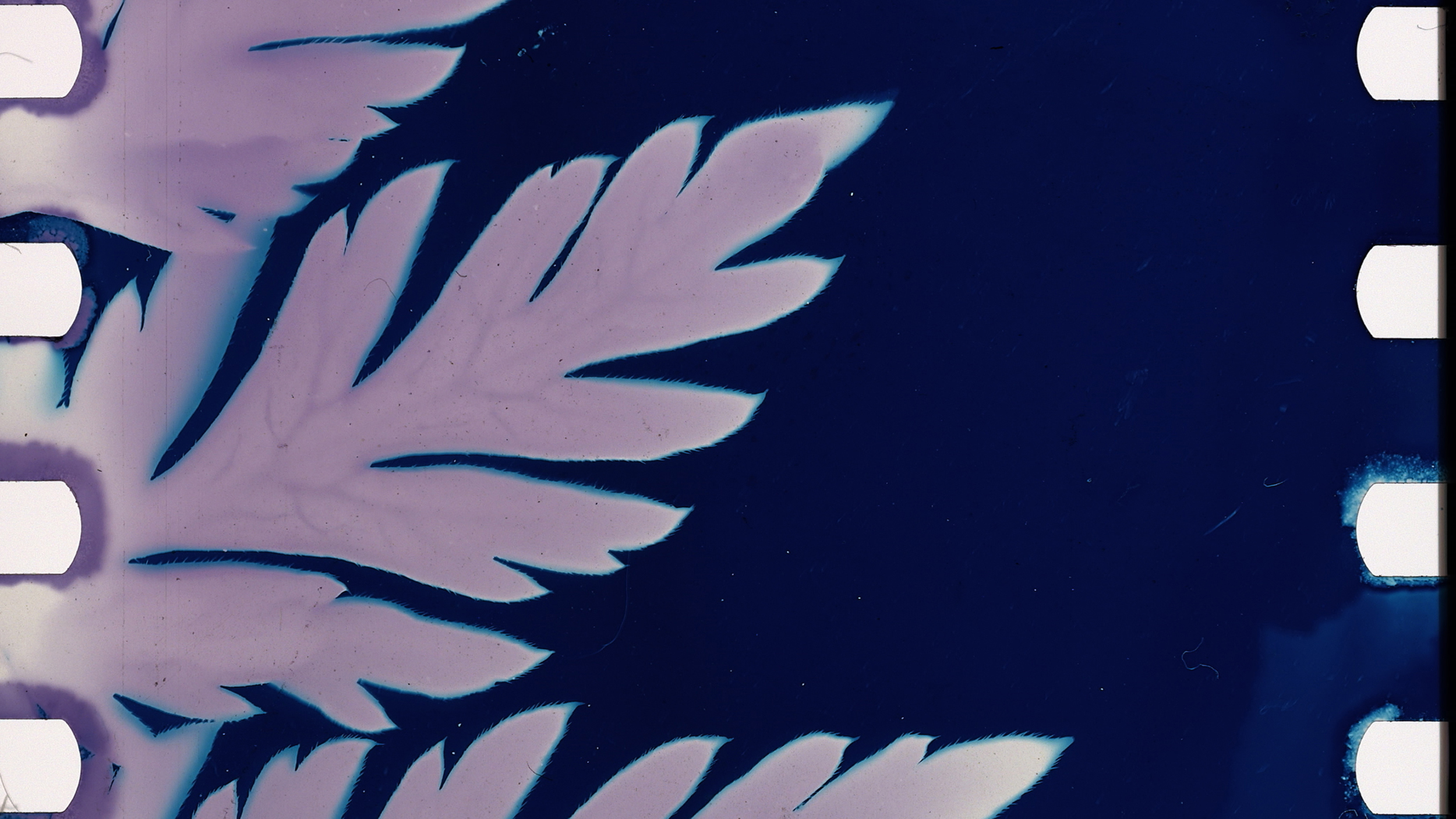
Films and Natural Processes
Screening ended—films streamed May 15–28, 2020
Saltwater, plastic, toxic minerals, sand or waste: matter accumulates and overwhelms, dissolves, decomposes, and reforms.
With the widespread closure of movie theaters and screening rooms, online experiences of film and media works are increasingly facilitated by digital devices. Material relations and components enmesh these objects within earthly cycles and natural processes as matter is mined, assembled, used, discarded or recycled—the aluminum that provides a polished shell for many laptops is also an abundant metallic element found in the Earth’s enveloping crust.
This program brings together a selection of films that emerge from material interactions between moving images and natural processes. Coated with chemicals and exposed to sunlight, Kelly Egan’s Athyrium filix-femina reveals the impressions of delicate botanical specimens against cyan blues. Strips of film have been dragged along a mud and salt crystal encrusted spiral on the shore of Utah’s Great Salt Lake or a pink beach off the coast of Sardinia in works by Jennifer West. The rhythms of sand merchants laboring on the outskirts of Lagos are reflected by the movements of images that lurch towards the ground before rolling back up for air in Karimah Ashadu’s Lagos Sand Merchants. A video essay by Louis Henderson presents the extraction of precious metals from enormous piles of obsolete computers across electronic waste sites in Ghana, grounding cycles of recycling and decay to tangible exertions. Acid green specks flicker like fireflies across brilliant ultramarine hues in an unearthed film exposed to radiation contamination by Tomonari Nishikawa, while Sasha Litvintseva and Graeme Arnfield’s Asbestos foregrounds the effects of a fibrous mineral that is toxic but invisible to the naked eye, revealing the persistence of matter across bodies, materials, and environments. Fluxes of matter substantiate the reverberations of the earth.
This screening was developed as part of the Department of Cinema and Media Studies and Smart Museum of Art’s Graduate Curatorial Internship, co-sponsored by the Film Studies Center.
From Soil, Sand, and Salt Crystals is curated by Sophie Lynch, Smart Museum Curatorial Graduate Intern for Media Programming and PhD student, Cinema and Media Studies Department at the University of Chicago.
Screening
The films in this program were available for on-demand streaming on this page from May 15–28, 2020.
FEATURING WORKS BY
Kelly Egan, Jennifer West, Karimah Ashadu, Jürgen Reble, Dana Claxton, Tomonari Nishikawa, Sasha Litvintseva and Graeme Arnfield, Annapurna Kumar, Jennifer Reeves, Louis Henderson, Lei Lei and Thomas Sauvin.
RELATED PROGRAMS
Friday, May 15, 2020, 7 pm
Panel Discussion: Kelly Egan, Jennifer West, and Lei Lei
A virtual panel discussion with filmmakers Kelly Egan, Jennifer West, and Lei Lei. Moderated by Sophie Lynch.
Wednesday, May 27, 2020, 1 pm
Panel Discussion: Karimah Ashadu, Sasha Litvintseva & Graeme Arnfield, and Tomonari Nishikawa
A virtual panel discussion with filmmakers Karimah Ashadu, Sasha Litvintseva & Graeme Arnfield, and Tomonari Nishikawa. Moderated by Sophie Lynch.
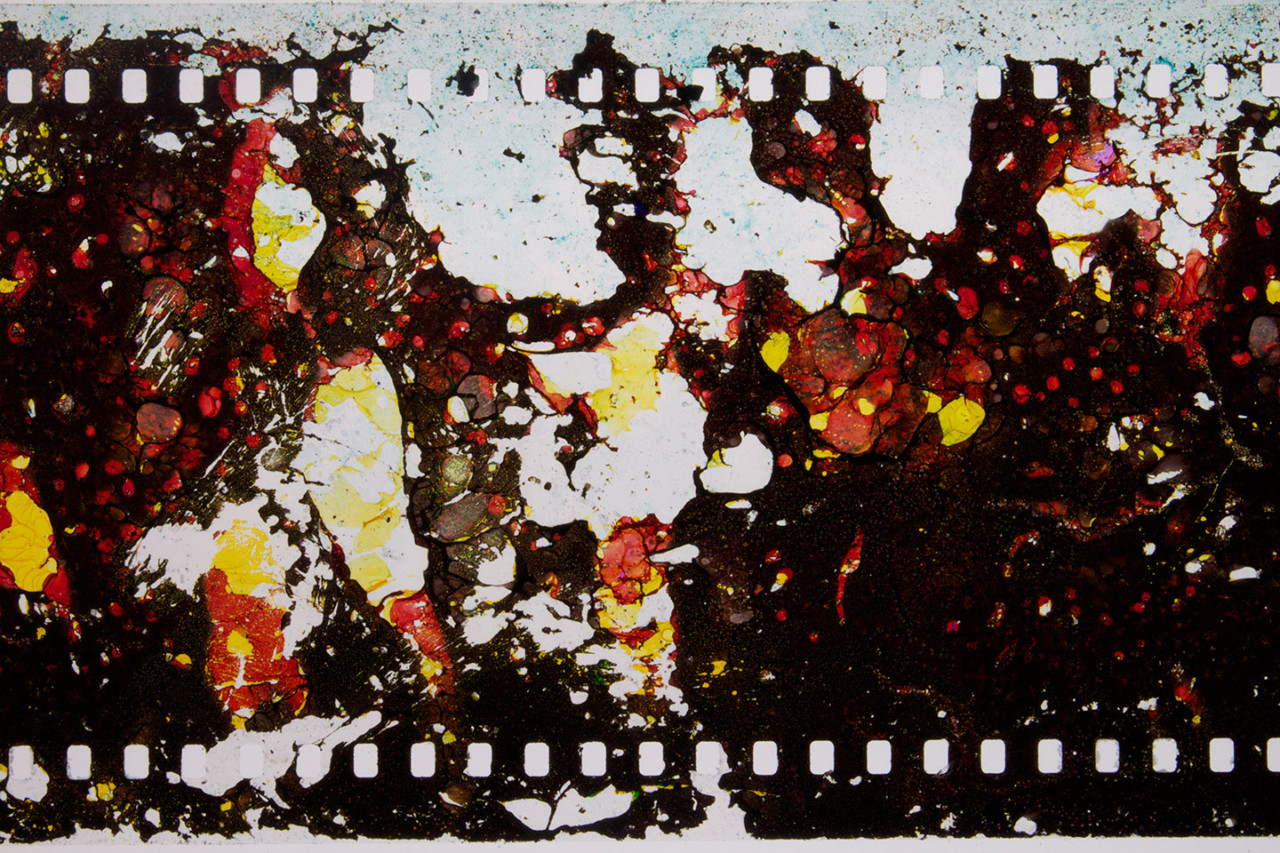
Full film program
- Athyrium filix-femina, Kelly Egan, 2016, color, handmade cyanotype emulsion, 5 minutes.
Kelly Egan’s Athyrium filix-femina reveals the impressions of delicate botanical specimens against cyan blues in an homage to the photographer and botanist Anna Atkins’s nineteenth-century cyanotypes of algae, plants and ferns. Egan arranged wisps of plants on clear 35mm film painstakingly coated with chemicals before exposing the filmstrips to sunlight. Weaving botanical photograms with found footage of a young girl and a spider imprisoned inside a glass jar, the film combines filmmaking with the patterns of quilt-making practices to explore the handmade aspects of photography, film and traditional domestic work.
- Salt Crystals Spiral Jetty Dead Sea Five Year Film (70mm film negative floated in the Dead Sea and given a healing clay bath in extreme heat in 2008 – stuffed in a suitcase, placed in studio buckets, covered in clay and salt for five years – dragged along the salt encrusted rocks of the Spiral Jetty and thrown in the pink waters in 2013 in below 10 degree weather – Dead Sea floating and mud baths by Mark Titchner, Karen Russo and Jwest – Spiral Jetty dragging and rolling by Aaron Moulton, Ignacio Uriarte and Jwest – DIY telecine frame by frame of salt covered film by Chris Hanke), Jennifer West, 2013, 70mm film negative transferred to high-definition, 54 seconds.
Geological elements and erosion leave marks on a strip of 70mm film that floated in the Dead Sea and soaked in clay before getting stuffed in a suitcase to be brought back to Los Angeles, where it was submerged and sat in buckets filled with mud and salt for years in the artist’s studio. After five years, Jennifer West dragged the film along the mud and salt crystal encrusted spiral of Robert Smithson’s Spiral Jetty before throwing it in the icy pink waters of Utah’s Great Salt Lake—the film’s frames were then digitally photographed and re-stitched together. Through material traces of mud, salt crystals and sand, distant places and layered temporalities flicker across a film that lasts less than one minute.
- Tar Pits Film (16mm film negative thrown in the La Brea Tar Pits, ridden over hot tarmac by a motorcycle, soaked in kitty litter, lighter fluid, mayonnaise and body lotion), Jennifer West, 2006, 16mm film negative transferred to digital video, 2:21 minutes.
Tar pits form as petroleum seeps to the surface through fissures in the Earth’s crust, leaving viscous asphalt pools. To make Tar Pits Film, Jennifer West threw a strip of film into the La Brea Tar Pits in Los Angeles, still-bubbling asphalt pools which have seeped from the ground for tens of thousands of years. The film was then ridden over hot asphalt by a motorcycle and drenched in other substances including thick mayonnaise and body lotion.
- Pink Beach Red Desert Dream Sand Film (Russian 35mm film print of the dream sequence of Michelangelo Antonioni’s film, Red Desert – won on Russian Ebay – taken to Pink Beach off the coast of Sardinia, Italy where the film was shot in the early 60’s and dragged along the pink sand beach cove sand, rocks and bushes – sandy film transferred to HD by hand frame by frame), Jennifer West, 2017, 35mm film print hand-transferred to HD with sound, 3:21 minutes.
Jennifer West won a 35mm film print of Michelangelo Antonioni’s film Red Desert (1964) on Russian Ebay and dragged it along the Pink Beach off the coast of Sardinia, Italy, where some scenes of the film were shot. Fragments of coral and crushed shell create pink-hued sand that mark the surface of Antonioni’s first color film. Grains of sand and rocks coalesce upon and scratch the surface of the film, which was then transferred to HD frame by frame.
- Lagos Sand Merchants, Karimah Ashadu, 2013, HD digital film, color, sound, 9:21 minutes.
The repetitive motions of sand merchants working on the outskirts of Lagos are reflected by the movements of a camera positioned on a revolving device in Karimah Ashadu’s Lagos Sand Merchants. The dynamic mechanism produces a rhythm that mirrors the task of merchants unearthing sand from the lagoon—moving images and laboring bodies lurch towards the ground before rolling back up or surfacing for air.
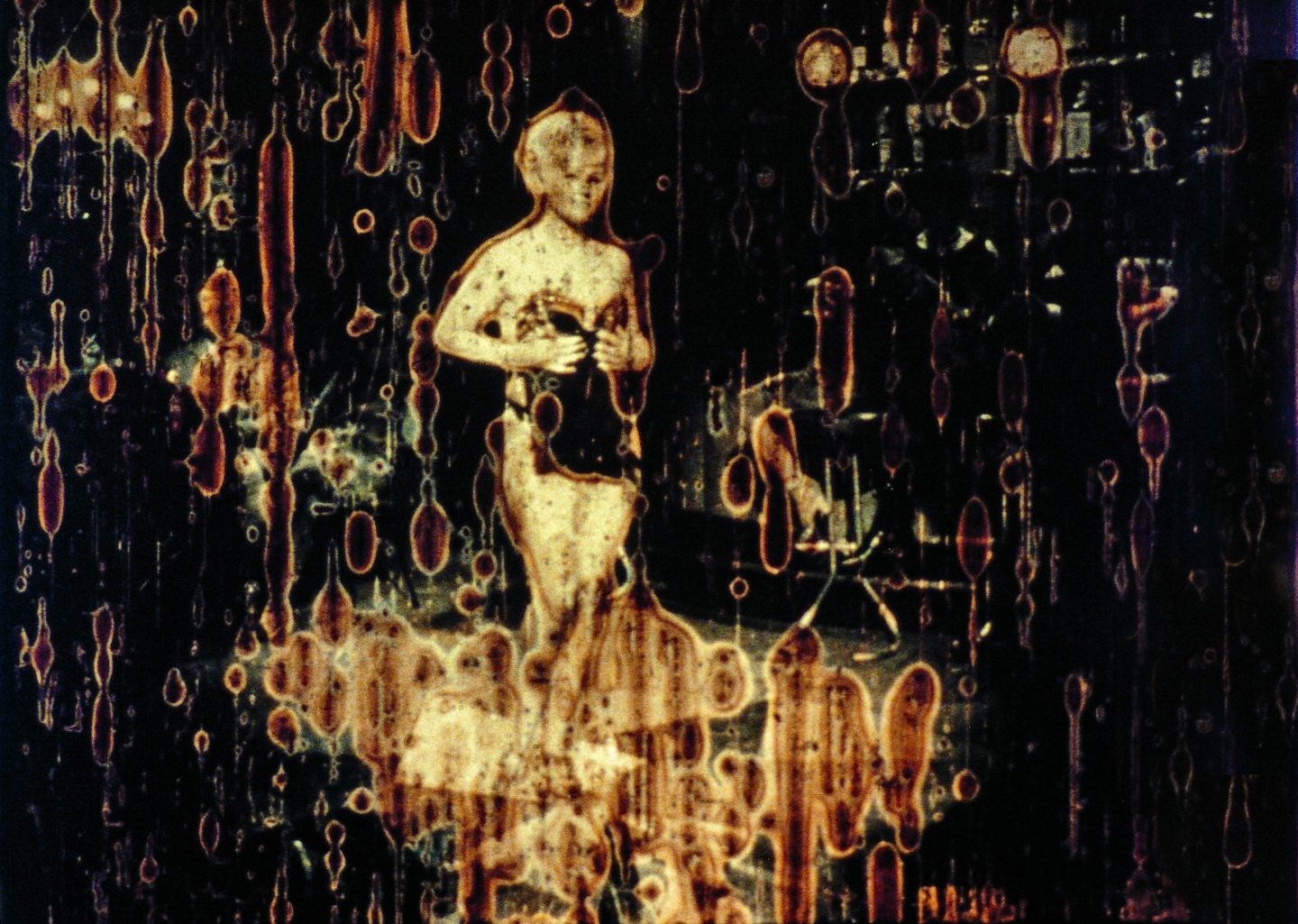
- Zillertal, Jürgen Reble, 1991, color, sound, 10:00 minutes.
Jürgen Reble hung an old film trailer in the trees of a garden for months, exposing found footage to rain, sun and wind and sometimes coating the weathered film strip with chemicals. In Zillertal, which refers to a Tyrolean mountain range, the film is slowed down and decaying images reform into mountainous shapes. Eruptions of color grow out of black and white areas as slow-moving figures seem to melt and metamorphose to a soundtrack composed of the rhythmic clicks of a film projector.
- Tree of Consumption, Dana Claxton, 1993, b&w, sound, 11:47 minutes.
Dana Claxton uses low-grade video equipment to create degraded images that correlate the treatment of the earth with the treatment of women’s bodies. A figure stands enmeshed in cutting barbed wire among ravaged forests and chopped tree stumps. Grainy black-and-white images have been electronically ripped, cut and torn in post-production while repeated images of the artist’s open-mouth scream silently against a volatile red sky. A video work from the early 1990s continues to resonate in our contemporary moment—and with decades of missing and murdered Indigenous women across exploited lands.
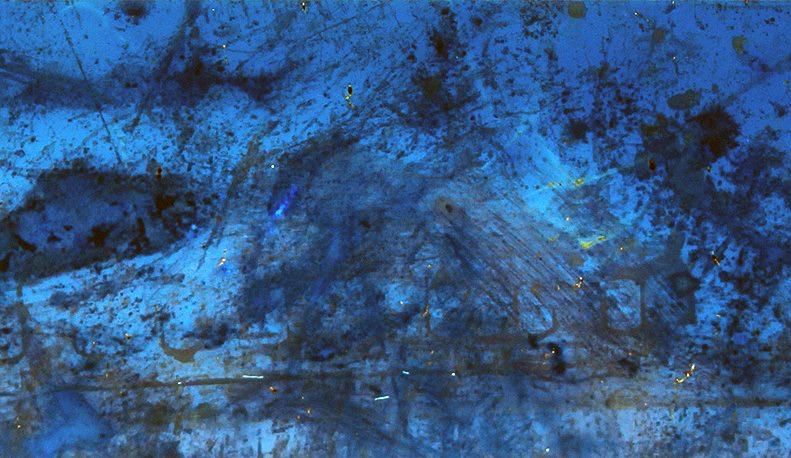
- Sound of a Million Insects, Light of a Thousand Stars, Tomonari Nishikawa, 2014, color, sound, 2:00 minutes.
Tomonari Nishikawa buried a 100-foot 35mm negative film under fallen leaves along a road near the Fukushima Daiichi Nuclear Power Station at sunset until sunrise the following day. As Nishikawa recounts, “The night was beautiful with a starry sky, and numerous summer insects were singing loud.” Acid green specks flicker like fireflies across brilliant ultramarine hues in an unearthed film possibly exposed to radiation contamination.
- Asbestos, Sasha Litvintseva and Graeme Arnfield, 2016, HD digital film, 20 minutes.
Shot in the mining town of Asbestos, Québec, Sasha Litvintseva and Graeme Arnfield’s film excavates the persistence of a silicate mineral composed of fibrous crystals, long mined as a miracle material of the construction industry. Asbestos uses found footage to unearth the transformation of asbestos extractions from the earth’s crust to the walls of homes and buildings, mining what the filmmakers describe as the remains of a toxic dream.
- Mountain Castle Mountain Flower Plastic, Annapurna Kumar, 2017, HD digital video, 3:07 minutes.
Throbbing landscapes emerge from pastel-filled plastic bottle shapes; the drawn outline of a Styrofoam container closes before pulsating rock fragments enclosed within a morphing snow-capped mountain. Mountain Castle Mountain Flower Plastic is an experimental animation “inspired by hard-drive prototypes accidentally turning into an environmental film.”
- Landfill 16, Jennifer Reeves, 2010-2011, b&w and color, sound, 9 minutes.
Cycles of recycling and decay are realized as soil accumulates with the movement and colors of hand-painted footage in Jennifer Reeves’s Landfill 16. Reeves temporarily buried 16mm film outtakes that might have usually ended up in a landfill in a backyard in Elkhart, Indiana. Unearthed, the decomposed images vibrate with hand-painted hues in an abstract moving work that the filmmaker describes as a “meditation on the demise of the beautiful 16mm medium and nature’s losing battle to decompose the relics of our abandoned technologies and productions.”
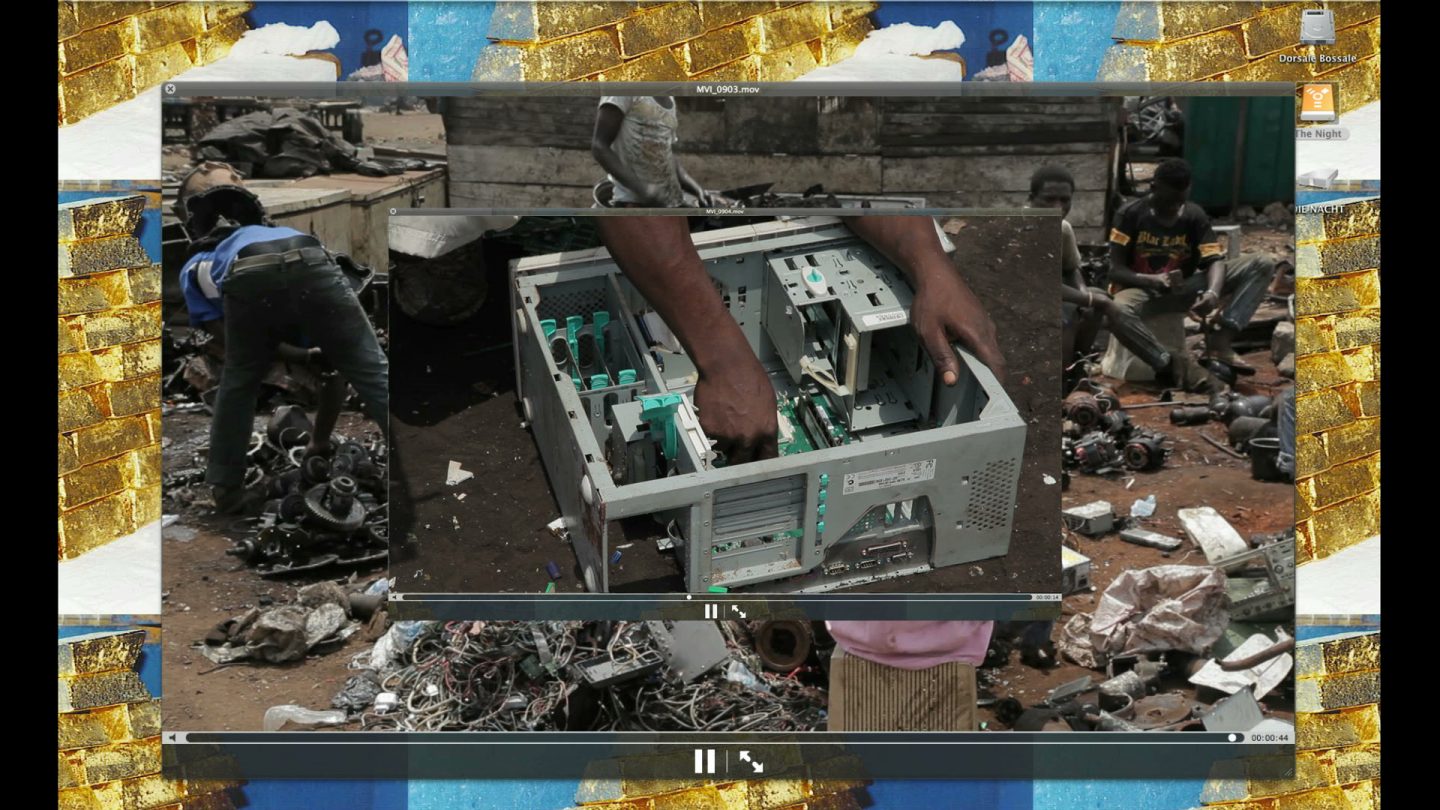
- All That is Solid, Louis Henderson, 2014, HD digital film, 16 minutes.
Louis Henderson’s video essay All that Is Solid presents the extraction of precious metals from enormous piles of obsolete computers across the Agbogbloshie electronic waste grounds and illegal gold mines in Ghana. Electronics are stripped as precious metals get extracted and recuperated by laboring workers before getting sold, melted and recycled into new objects, grounding the myth of the immateriality of new technology to tangible exertions and earthly elements.
- Recycled, Lei Lei and Thomas Sauvin, 2013, HD video, 5:32 minutes.
Recycled is composed of thousands of discarded 35mm negatives found in a recycling zone on the outskirts of Beijing, where they had been sent to get filtered for their silver nitrate content. Vernacular images of inhabitants engaged in ordinary activities during multiple decades get salvaged and pulsate in an animated work to create a portrait of a city in transformation.